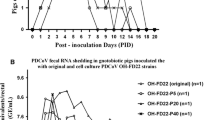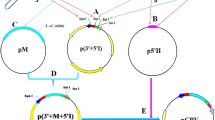Summary
Persistent infections (Pi) were established in two host-cell systems [Madin-Darby bovine kidney (MDBK) and Madin-Darby canine kidney (MDCK)] with Sendai virus and three strains of NDV, to test the influence of different viruses and host-cell systems.
Virus was recovered from the persistently infected cells. An RNA- ts mutant was recovered from a Pi of MDBK cells, but no Pi could be established in MDCK cells with the three strains of NDV. Additionally, the Pi was established exclusively by a virulent strain, NDV-Milano.
On the other hand, Sendai virus could establish Pi in MDBK and MDCK cell-systems. Several ts mutants were recovered from “late” passages of Pi, and from an accidental infection, a ts mutant with an altered P polypeptide. Ten other ts mutants were tested, however, the specific ts lesion could not be identified. From three Pi in MDCK cells, host range mutants (ts-f1, ts-f2, and ts-f3) were recovered. One of the mutants (ts-f1) has an altered M (matrix) protein. The host range mutants undergo a productive infection in MDBK and MDCK cells, which are nonpermissive for wild type Sendai virus. The possible significance of the results are discussed.
Similar content being viewed by others
References
Apelian, Z., Hong, L.-C., Seto, J. T.: Scanning electron microscope examination of epithelial cells infected with enveloped viruses. J. Virol. Methods8, 147–154 (1984).
Cowley, J. A., Tannock, G. A., Barry, R. D.: A simple procedure for the analysis of influenza and parainfluenza virus involving adsorption to erythrocytes. J. Virol. Methods8, 9–18 (1984).
Garten, W., Berk, W., Nagai, Y., Rott, R., Klenk, H.-D.: Mutational changes of the protease susceptibility of glycoproteins F of Newcastle disease virus: Effects on pathogenicity. J. gen. Virol.50, 135–147 (1980).
Holland, J., Spindler, K., Horodyski, F., Grabau, E., Nichol, S., Vanderpol, S.: Rapid evolution of RNA genomes. Science215, 1577–1585 (1982).
Kawaoka, Y., Naeve, C. W., Webster, R. G.: Is virulence of H5N2 influenza viruses in chickens associated with loss of carbohydrate from the hemagglutinin? Virology139, 303–316 (1984).
Kimura, Y., Orvell, C., Norrby, E.: Characterization of the polypeptides synthesized in cells infected with a temperature-sensitive mutant derived from HVJ (Sendai virus) carrier culture. Arch. Virol.61, 23–33 (1979).
Lamb, R. A., Mathy, B. W. J., Choppin, P. W.: The synthesis of Sendai virus polypeptides in infected cells. Virology69, 116–131 (1976).
Nagai, Y., Klenk, H.-D., Rott, R.: Proteolytic cleavage of the viral glycoproteins and its significance for the virulence of Newcastle disease virus. Virology72, 494–508 (1976).
Ogura, H., Sato, H., Hatano, M.: Temperature-sensitive HVJ (Sendai virus) with altered P polypeptide derived from persistently infected cell lines. J. gen. Virol.55, 469–473 (1981).
Roux, L., Beffy, P., Portner, A.: Restriction of cell surface expression of Sendai virus hemagglutinin-neuraminidase glycoprotein correlates with its higher instability in persistently and standard plus defective interfering virus infected BHK-21 cells. Virology138, 118–128 (1984).
Scholtissek, C., Rott, R.: Behavior of virus-specific activities in tissue cultures infected with myxoviruses after chemical changes of the viral ribonucleic acid. Virology22, 169–176 (1964).
Seto, J. T., Garten, W., Rott, R.: The site of cleavage in infected cells and polypeptides of representative paramyxoviruses grown in cultured cells of the chorioallantoic membrane. Arch. Virol.67, 19–30 (1981).
Seto, J. T., Rott, R.: Functional significance of sialidase during influenza multiplication. Virology30, 731–737 (1966).
Seto, J. T., Wahn, K., Becht, H.: Electron microscope study of cultured cells of the chorioallantoic membrane infected with representative paramyxoviruses. Arch. Virol.65, 247–255 (1980).
Urata, D., Seto, J. T.: Glycoproteins of Sendai virus: Purification and antigenic analysis. Intervirology6, 108–114 (1975/76).
Yoshida, T., Hamaguchi, M., Naruse, H., Nagai, Y.: Persistent infection by a temperature-sensitive mutant isolated from a Sendai virus (HVJ) carrier culture: Its initiation and maintenance without aid of defective interfering particles. Virology120, 329–339 (1982).
Youngner, J. S., Preble, O. T.: Viral persistence: Evolution of viral populations. In:Fraenkel-Conrat, H., Wagner, R. R. (eds.), Comprehensive Virology, Vol. 16, 73–135. New York: Plenum Press 1980.
Author information
Authors and Affiliations
Additional information
With 5 Figures
Rights and permissions
About this article
Cite this article
Lawton, P., Karimi, Z., Mancinelli, L. et al. Persistent infections with Sendai virus and Newcastle disease viruses. Archives of Virology 89, 225–233 (1986). https://doi.org/10.1007/BF01309891
Received:
Accepted:
Issue Date:
DOI: https://doi.org/10.1007/BF01309891




